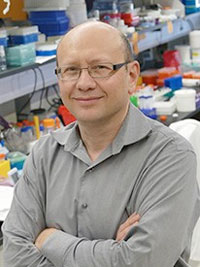| Jan 14, 2019 | |
New immune system understanding may lead to safer nanomedicines(Nanowerk News) Doctors would like to use all sorts of nanoparticles in the body, for example to construct detailed images of anatomy and disease, and to deliver cancer-fighting drugs deep within tumor tissue. However, millions of years of evolution have equipped the body to identify and reject foreign particles, even nanoparticles. And so one major challenge in the use of nanomedicine has been the immune system's unfortunate efficiency in responding to what it sees as infection, at best clearing nanoparticles before they can accomplish their goals, and at worst, leading to dangerous immune overreaction that creates side effects and serious risks. |
|
| A University of Colorado Cancer Center study published in the journal Nature Nanotechnology ("Immunoglobulin deposition on biomolecule corona determines complement opsonization efficiency of preclinical and clinical nanoparticles") describes an important step in the activation of the immune system against nanoparticles. The finding may allow researchers and eventually doctors to cloak nanoparticles against the immune system, allowing these particles to go about their therapeutic business. | |
 Dmitri Simberg Previously, the lab of CU Cancer Center investigator Dmitri Simberg, PhD, has shown that blood proteins (collectively called protein corona) coat nanoparticles, marking them for immune system attack. In particular, the Simberg lab showed that one of the most important components of the immune system, namely the complement system, cannot attack nanoparticles unless they are coated with protein corona. Now the Simberg lab shows another step in this process: Natural antibodies within the protein corona are responsible for the ability of the complement system to recognize and attack nanoparticles. "Basically, we found that C3 deposition on nanoparticles (and thus immune system activation against nanoparticles) really depends on natural antibodies in each person's blood," says Simberg, who is also an associate professor in the Skaggs School of Pharmacy and Pharmaceutical Sciences. "We can remove these antibodies and there is very little complement system activation. Then we can add these antibodies back and there is activation. The study, which was done in collaboration with Moein Moghimi, PhD, Professor at Newcastle University in the UK, looked at the ability of a prevalent complement system protein, known as C3, to find and attack widely used nanoparticle-based anti-cancer pharmaceuticals LipoDox and Onivyde, (as well as the nanoparticle-based iron oxide supplement Feraheme). When Simberg and colleagues depleted antibodies known as immunoglobulins from blood of healthy donors and cancer patients, the ability of C3 to find and mark these nanoparticles was reduced 70-95 percent. When the team restored immunoglobulins, they again saw C3 buildup on these nanomedicines. |
|
| "Our immunological memory is made up of antibodies that help us to recognize pathogens that we may have encountered long ago. Each person has a set of natural antibodies that recognizes nanoparticles. The individual reactivity of a person to a specific kind of nanoparticle depends to some extent on how much of these antibodies a person has. There's variability - one person may have more antibodies that recognize a certain kind of nanoparticle, while another person has different antibodies that recognize another kind of nanoparticle," says Simberg. | |
| "What is really exciting is that all these antibodies seem not to bind to naked nanoparticles. The particle needs to be coated with a protein corona - binding of these antibodies is much more efficient when you have these other proteins sticking to the nanoparticles first," Simberg says. | |
| Continuing work hopes to discover the origin and source of antibodies that recognize nanoparticles, offering a clearer picture of why some people show immune over-response in reaction to nanoparticle-based medicines. By understanding how antibodies recognize nanoparticles, Simberg and his team hope to develop ways to selectively block this action, leading to more effect and less side effect of nanomedicines. |
| Source: University of Colorado Anschutz Medical Campus | |
|
Subscribe to a free copy of one of our daily Nanowerk Newsletter Email Digests with a compilation of all of the day's news. |
